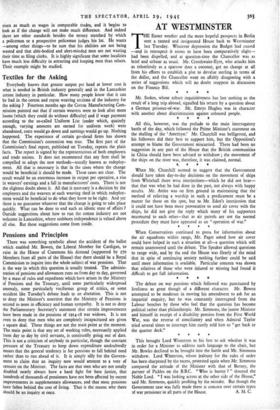Textiles for the Asking
Everybody knows that greater output per head at lower cost is what is needed in British industry generally and in the Lancashire cotton industry in particular. How many people know that it can be had in the cotton and rayon weaving sections of the industry for the asking ? Fourteen months ago the Cotton Manufacturing Com- mission pointed out that if certain weavers were to look after more looms (which they could do without difficulty) and if wage payment according to the so-called Uniform List (under which, quaintly enough, varying amounts are earned for uniform work) were abandoned, costs would go down and earnings would go up. Nothing happened. The experience of certain go-ahead firms has shown that the Commission's contention was true. The first part of the Commission's final report, published on Tuesday, repeats the plain facts. The report is signed by the representatives of both employers and trade unions. It does not recommend that any firm shall be compelled to adopt the new methods—usually known as redeploy- ment. All that is necessary is that in the cases where the change would be beneficial it should be made. These cases are clear. The result would be an enormous increase in output per operative, a rise in weavers' earnings and a fall in manufacturers' costs. There is not the slightest doubt about it. All that is necessary is a decision by the employers and the weavers at each weaving shed in which redeploy- ment would be beneficial to do what they know to be right. And yet there is no guarantee whatever that the change is going to take place quickly. What can be done to end such an idiotic state of affairs ? Outside suggestions about how to run the cotton industry are not welcome in Lancashire, where stubborn independence is valued above all else. But these suggestions come from inside.


































 Previous page
Previous page